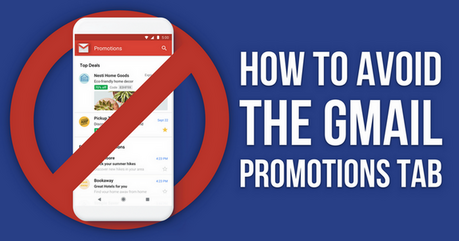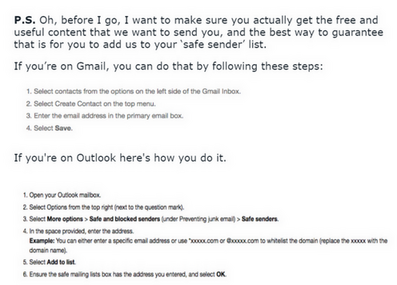
Seven years ago, Gmail made significant updates, and one of the major updates was the Promotions Tab. When I first heard about the update, I knew it would make email marketing much more difficult for digital marketers, including myself.
Getting your email clicked and opened is already a challenge, more so when your emails are isolated in a folder with only a 19.2% read rate.
It’s not that promotional emails are less valued than other emails. However, being on the Promotions Tab gives them a lesser chance of being opened than emails in the Primary Tab.
No wonder many email marketers thought the rise of the Promotions Tab was the fall of email marketing.
There’s no need to fret, though. Email marketing is still effective. In fact, many marketers have gotten a 760% increase in revenue through email marketing, according to our friends over HubSpot.
The challenge, however, is creating emails that won’t fall under the Promotions Tab, where there is a stockpile of other ads.
Your goal is to bring your email to your recipient’s Primary tab, where they always go and open emails. When done successfully, you get higher chances of increasing conversion rates and making sales.
How to Keep Your Emails From Promotions Folder
To avoid the pit of Promotions Tab, you need to know what exactly brings emails to get into this folder.
Gmail’s algorithms scan every incoming email. And when it detects something promotional within an email, it diverts it to the Promotions tab.
Gmail’s algorithm is always changing. That’s for sure. Hence, there’s no one specific way to keep your emails from getting into the Promotions tab.
The good news is that there are specific steps you can take to increase the probability of your emails getting into your recipients’ Primary tab.
Ask your subscribers to add you to the Primary tab (and be human about it).
The best way to ensure that your emails get into the Primary tab is to ask your subscribers to do it manually. You will need to request them to change your email label by clicking the labels icon on top of the email, then uncheck Promotions.
The best way to ensure that your emails get into the Primary tab is to ask your subscribers to do it manually. You will need to request them to change your email label by clicking the labels icon on top of the email, then uncheck Promotions.

By doing so, the email (and future email from you) gets transferred to the Primary folder. When your subscribers uncheck Promotions in your emails, it will tell Gmail that your emails should be in the Primary tab.
This is the manual process, and most of the time, your subscribers will be more willing to do it, especially when you explain the benefit of them doing so.
You may also ask your subscribers to add you to their contact list. And while you’re at it, make sure to tell them how to make the process for them much more manageable.
Here’s an example:

Make your emails more personalized.
We’ve talked about this before, and we’ll talk about it once again.
Personalizing your emails (meaning making them targeted to specific audiences) is one of the best ways to ensure your emails don’t fall under the Promotions tab.
When structuring your emails, it’s best to curate it as if you’re writing to a friend. Be conversational but not overly casual. Be professional, but not too salesy. We found that sharing stories is very effective. Adding appropriate humor is good, too.
Personalized emails tell a lot about you and your brand. For one, they show that you care about your subscribers. Second, you understand what they need and provide them with the best solutions. Personalizing your emails can exponentially increase your open and click-through rates, resulting in lead conversion and sales.
The first step to making personalized emails is segmentation. Group your subscribers according to age range, demographics, buying habits, location, and so on. Using this information, you can structure relevant emails specific to each group.
One more thing, it’s best to avoid sending bulk emails. Blasting your emails to your entire email list can only do more harm than good. When you do so, chances are Gmail will flag your email as spam or promotions.
Instead, create emails specific to what your subscribers need. This requires extra work, but it can go a long, long way.
Use images cautiously.
Images can grab your subscribers’ attention. With pictures, you can show them your latest product, the items on sales, and even the best-selling goods. But while images can hook your subscribers, they can also be the reason why your emails go into the Promotions tab.
So instead of cramming your emails with images, use them sparingly. One image with a small file size should be enough.
Plus, avoid using your business logo as your profile picture. Gmail may flag it as a Promotional email or spam.
Avoid salesy words or phrases.
Starting your email with phrases like “FREE Gift Card,” “60% OFF TODAY,” “Limited offer only” is tempting (and sure sounds like a good idea), but these phrases, among others, can be flagged as spam.
When an email sounds like an advertisement, Gmail automatically sends it to the Promotions tab. But more often than not, they get into the Spam folder.
Promote your brand without being too promotional. Be smart with your subject lines, and avoid adding words related to selling and marketing (like dollar signs, “free,” etc.).
Add CTAs effectively.
Links play an essential role in email marketing. By adding links to your email, you lead your prospects and subscribers to your website, landing page, blog, or social media accounts. But while links are useful, too much of it can result in your emails being sent to the Promotions tab.
Two to three links should work just fine. Remember, though, that the Unsubscribe button counts as a link, too.
Add one easy-to-access call to action. And instead of using phrases like “Buy Now” or “Get your FREE access now,” use phrases that aren’t too pushy, such as “Learn more” or “Continue.”
Be mindful of your email address.
Remember when I said to structure your email as if you’re writing to a friend? That involves checking your email address, too. When you write to a friend, you keep your reply-to email address the same as your address in the sender field.
When you have a different reply-to address, Gmail’s algorithm will detect your email as promotional, resulting in Gmail diverting your email to the Promotions tab.
So before hitting send, make sure your reply-to address matches your email address in the sender field.
Further, Gmail knows when you’re using your business email or personal email. Instead of using info@abc123company.com, use name@abc123company.com.
Something to think about…
You don’t entirely have to fear the Promotions tab. The read rate is only 19.2%, but let’s not forget to look at the bigger picture. Emails in the Primary folder only get a 22% read rate. That means emails in the Primary tab aren’t read as much as promotions.
While getting into your subscriber’s Primary tab gives your email more exposure, that doesn’t necessarily guarantee your email gets clicked and opened. There are several factors in play: your subject line, content, and CTA. Hence, ensure to work on these elements, too.
If you’re having a hard time launching email campaigns, don’t hesitate to contact us. We’ve been working on email campaigns for over ten years, and throughout the years, we’ve helped many businesses expand through email marketing.
We use tools such as ActiveCampaign, HubSpot, or InfusionSoft to implement effective campaigns. Contact us, and we can discuss which tool best fits your business.
Share this post with your friends

Ross Jenkins
Ross Jenkins is the founder of DigitalME and is an ActiveCampaign Certified Consultant. He is ranked #1 on UpWork for his proficiency in digital marketing. DigitalME offers targeted digital solutions and is perfect for anyone who wants to increase leads, sales, and productivity through automation.